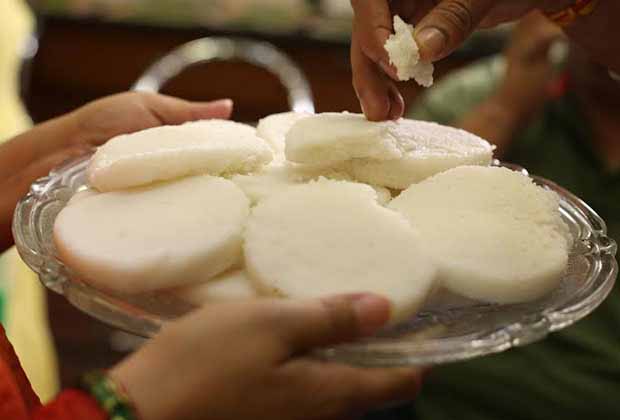5 Maharashtrian cooking styles you need to know
- By Rituparna RoyLoading...
- | 26 May 2015 2:50 PM IST
 X
X
 Sandan, a Konkani pancake prepared with rice flour
Sandan, a Konkani pancake prepared with rice flour
The diverse food culture of Maharashtra is marked by the use of desi or local ingredients, which varies from the coast to the plains. Take coconut for instance. While one community prefers to use dry coconut in some of their dishes, another chooses to prepare the same with a fresh or wet version of it.
Freshly ground masalas form the highlight of Maharashtrian cooking, and is the reason behind its aromatic amtis, rassas and kalvans.
To understand the diversity of Maharashtrian cuisine, APB Cook Studio on Saturday showcased the culinary legacy of the state. Hosted by Rushina Munshaw-Ghildiyal and team, ‘Maharashtrian Mejwani’ saw popular faces from the community featuring food bloggers and writers, historians and experts who shared memorable experiences around their food.
What transpired was a celebration of varied spices and cooking styles of Kolhapuri, Konkani Muslim, Deshastha Brahmin, Koli and Pathare Prabhu styles of cooking.
This is by no means an exhaustive list. Communities such as CKP, Khandeshi and the Vidharbha region of the state have their distinctive style of cooking.
Kolhapuri cuisine: If you have ever driven to Goa, then you’d have definitely made a pit stop in Kolhapur to feast on the Tambda Rassa. But, author of Rare Gems: A Non-Vegetarian Gourmet Collection from Maharashtra, Aditya Mehendale says that Kolhapuri cuisine is much more than Tambda and Pandra Rassa.
The use of kanda-lasun (onion & garlic), sukha kopra (dry coconut) and generous amounts of red chilli powder give its chicken, mutton and seafood delicacies the bold and fiery character.
 A light coconut drink flavoured with spices called Koval
A light coconut drink flavoured with spices called Koval
Konkani Muslim: Did you know that the traditional way of preparing rice in Konkan is by boiling it in coconut milk? Professor and food historian, Dr. Mohsina Mukadam says, “The food of Konkani Muslims is not just biryani and kebabs! Our spices and dishes are heavily influenced by traders who came to the coast from Saudi Arabia and those that we learned from our Hindu neighbours.”
Apart from seafood, mutton and chicken curries, the Konkani Muslims take pride in their fish biryanis prepared with prawns and pomfret. Sandan, a pancake-like sweet prepared with coconut or rice flour brings people together because of its big size, and also has a seven-layered version stuffed with dry fruits.
Deshastha Brahmin: IFN Blogger Saee Koranne-Khandekar has fond memories of her childhood when she would prepare laddoos using peanuts with her friend during playtime. The food blogger and consultant says, “Peanuts are a vital part of Deshastha Brahmin cuisine for the simple reason being it is grown in abundance in the plateau region.”
Different types of grains, vegetables especially vangi or brinjal is a favourite among the Deshasthas. Amtis or a spiced dal preparation using dried kokum called amsul as a souring agent, is a speciality too. Goda masala, a concoction of dry coconut, sesame seeds, garam masala, cumin and coriander seeds is a treasured spice mix of the community.
Koli cooking: In Thal, 7 kms away from Alibaug, the Koli community has a staple diet of fish curry and rice. At night, the same would be reduced and consumed with rotis. Originally fishermen by occupation, the Kolis have a distinct food culture featuring masalas that are locally sourced and prepared.
The Koli masala lends an aromatic flavour to fish and chicken curries, which are typically cooked with coconut and lots of garlic. Anjali Koli, a food blogger and entrepreneur says, “Our mutton curry is quite similar to Bengalis as we prepare it with potatoes too!" Dried prawns or sode, which is also cooked with vegetable dishes are unique to Koli cooking.
 Prawn Pathwad (left) & Prawn Pulao cooked the Pathare Prabhu way
Prawn Pathwad (left) & Prawn Pulao cooked the Pathare Prabhu way
Pathare Prabhu cuisine: The 6000-odd community claims to be the original inhabitants of Mumbai, and adds to the culinary legacy of the state with its distinct ingredients. The Pathare Prabhus use less coconut and love their traditional spices or the sambhar mix, which is a concoction of several spices including wheat and gram flour.
The sambhar mix is used to prepare fish like Bombay Duck and prawns. Kunal Vijayakar, TV show host and author of Made in India says, “Pathare Prabhu food is easy and takes very less time to make. The ingredients used are less usually 3 - 4 and also requires fewer steps.”
Photos: APB Cook Studio



